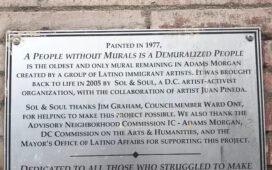By Jordan Cline, Library Intern
From the Maryland Historical Trust Library’s collection of hundreds of architectural drawings, we’ve exhumed the architectural drawings of Maryland’s most haunted historical buildings and sites documented on the Maryland Inventory of Historic Properties. Enjoy these terrifying tales of hauntings from across the state! Happy Halloween!

A Haunting in Glen Echo: the Clara Barton House (M: 35-25)
Although Clara Barton, the founder of the American Red Cross, was born in Massachusetts in 1821, she ultimately decided to call Maryland home. Her Glen Echo (Montgomery County) property initially served as a storage site for the American Red Cross and would later function as her residence and the charitable organization’s executive office from 1897 to 1912. Barton’s friend and roommate, Dr. Julian Hubbel designed the “unusual” house as a “Gothic Steamboat” style Victorian resembling a Mississippi riverboat. The house was built with the mission top of mind. The first-floor wall paneling—sourced from boards that were originally used to construct temporary housing for those displaced by the 1889 Johnstown, Pennsylvania flood—concealed deep closets for disaster relief supplies. On the second floor were living spaces for Barton, Dr. Hubbel, and George Pullman, who served as financial secretary for the Red Cross.



Clara Barton proved her dedication to the Red Cross retiring at the impressive age of 83 in 1904. She lived in her home until her death until 1912, after which Hubbel gave the home to his nieces, who converted into apartments. The property now operates as a museum, and it seems that Barton is still reluctant to cease working even in the afterlife. Some visitors have reported seeing a spectral Barton wearing a green dress floating through the halls of the home.
Paranormal Activity at Point Lookout (SM-271)
Touted as “America’s Most Haunted Lighthouse,”, the Point Lookout Light house was built in 1830 to aid navigation on the Chesapeake Bay at the opening of the Potomac. Just prior to the Civil War, Point Lookout enjoyed a reputation as a resort for residents of Washington, D.C. and Baltimore when William Cost Johnson took an interest in the area in 1857 and bought 400 acres, built a hotel, and leased 100 cottages. But the bucolic resort took on a more sinister role during the Civil War.
The United States government started Camp Hoffman at Point Lookout to garrison troops and store supplies. Johnson sold the hotel and cottages, and the government folded them into the complex to serve as a hospital in 1862. The year following the Battle of Gettysburg, Camp Hoffman took on an additional role as a prisoner-of-war camp. Camp Hoffman held around 20,000 Confederate soldier prisoners—more than double the occupancy limit. The cramped conditions for the soldiers were rife with disease—poor shelter and foul water contributed to the death of 4,000 Confederate soldiers. From 1862 to 1865, it is estimated that 52,000 prisoners were detained at Point Lookout. The government returned the prisoners’ remains home to their families or interred them at Point Lookout where they are in repose at a monument. Despite the atrocities of war that marked the region, Point Lookout rebounded as a popular summer resort in 1870s through the 1930’s. The lighthouse itself would continue to aid the maritime industry. Point Lookout Lighthouse from 1888 (MHT Library)The United States government started Camp Hoffman at Point Lookout to garrison troops and store supplies. Johnson sold the hotel and cottages, and the government folded them into the complex to serve as a hospital in 1862. The year following the Battle of Gettysburg, Camp Hoffman took on an additional role as a prisoner-of-war camp. Camp Hoffman held around 20,000 Confederate soldier prisoners—more than double the occupancy limit. The cramped conditions for the soldiers were rife with disease—poor shelter and foul water contributed to the death of 4,000 Confederate soldiers. From 1862 to 1865, it is estimated that 52,000 prisoners were detained at Point Lookout. The government returned the prisoners’ remains home to their families or interred them at Point Lookout where they are in repose at a monument. Despite the atrocities of war that marked the region, Point Lookout rebounded as a popular summer resort in 1870s through the 1930’s. The lighthouse itself would continue to aid the maritime industry.

Alan Brylawski ran the Point Lookout Hotel and wrote about his and others’ experiences with the paranormal in his 1989 column from The Chesapeake, “Letter from Point Lookout Hotel.” He reported that he felt “the presence of ‘goodness’ or ‘evil’ or ‘happiness’ or ‘sorrow.’” When he first walked into the hotel, he noted he was “greeted with a feeling of warmth. The place said to [him]…‘Come live with us’ and so [he] did!” The inn manager never had any ghostly experiences but believed that “some can ‘feel’ and some can ‘see’ ghosts better than others can.” Brylawski recounted that some visitors had also felt the presence of ghosts of the Civil War soldiers, with some of these ghostly presences “feeling sadness, others feel relief and others have felt a sense of comradeship!” A few people claimed to see ghostly soldiers as well.
Two other spirits have also been spotted at Point Lookout. The pirate Elmo T. Knottingly also allegedly haunts Point Lookout Park, searching for someone to help him dig up treasure hidden by Blackbeard. Author Ed Okonowicz in his book Haunted Maryland recorded the claims of a light housekeeper who reported seeing a distressed man in period clothing appear on the back porch. When the lighthouse keeper opened to the door to assist the man, “the figure floated across the lawn toward the bay.” Okonowicz speculated it was the spirit of an officer named Joseph Haney. Haney was a part of the crew of the steamboat Express that sank during a storm in October 1878. The officer likely perished while rowing to get the lighthouse keeper’s aid. His body was buried near by after washing up on shore. Point Lookout Fog Tower Bell Tower in 1910. Relatives of the Lighthouse are pictured in this photo Catherine Ardseer on the left and Rose Jeanette Ardeer (Chesapeake Bay Maritime Musem)Two other spirits have also been spotted at Point Lookout. The pirate Elmo T. Knottingly also allegedly haunts Point Lookout Park, searching for someone to help him dig up treasure hidden by Blackbeard. Author Ed Okonowicz in his book Haunted Maryland recorded the claims of a light housekeeper who reported seeing a distressed man in period clothing appear on the back porch. When the lighthouse keeper opened to the door to assist the man, “the figure floated across the lawn toward the bay.” Okonowicz speculated it was the spirit of an officer named Joseph Haney. Haney was a part of the crew of the steamboat Express that sank during a storm in October 1878. The officer likely perished while rowing to get the lighthouse keeper’s aid. His body was buried near by after washing up on shore.
Other residents of the lighthouse claim paranormal encounters. Gerry Sword, a state park employee who lived at Point Lookout with his dog, kept a list of unusual occurrences like crashing objects and hearing voices and footsteps. The final tenant of the lighthouse, Laura Berg, heard a woman singing and other mysterious voices. Her mother, Helen, was woken one night to someone calling her name. During her time there, Berg insisted she did not feel threatened by any spirits or ghosts. One ghost may have even alerted her to a fire. Okonowicz recounts that Berg’s most vivid memory was “being awakened one night and seeing an unusual series of six lights. She thought it might have been a reflection from a boat or a car but when she looked out, all was dark. As she became more awake, she suddenly smelled smoke. She jumped up and raced downstairs and found her space heater on fire. She was able to put the fire out, but the entire wire was burnt, as was the wall socket. She realized that if she hadn’t been awoken by the lights, the whole house could have burned, with her in it. She felt like someone was looking out for her and that she was safe.” These are just a few stories that attest to Point Lookout’s paranormal history.
Body Snatching at Davidge Hall (B-41)
After training in Glasgow and Edinburg—the premier medical universities of the 18th and 19th centuries—physician John Davidge co-founded the College of Medicine of Maryland in Baltimore where he also served as its first dean. Davidge, Dr. James Cocke, and Dr. John Shaw jointly offered classes in 1807 specializing in anatomy, surgery, midwifery, and chemistry, so Davidge built an anatomical theater for dissection. In November 1807, a throng of people broke into the building, carried out a cadaver, and dragged it through the streets of Baltimore. Although contemporary accounts of the riot did not mention the destruction of building, later accounts blame rioters for destroying the building. As a result of the riot, the faculty personally financed the construction of the campus. Davidge Hall, built in 1812 to replace the original theater, is remarkable as one of the few American university buildings to not only survive to the present day but to still be in use. The hall’s interior drew on the anatomical theaters in Europe and early medical educational buildings. Henry Latrobe, who built the anatomical theater at the University of Pennsylvania in 1806, also gave diagrams to assist the builders in their design of Davidge Hall.
Several measures were taken to protect the building from future rioters including moving the theater to a location removed from downtown Baltimore and building a 15-foot brick wall with a gate. The gatekeeper monitored people who entered and left the building and resided in Davidge Hall to keep an eye on things.
The intention to deter would-be rioters is also reflected in the interior of Davidge Hall. As noted by Larry Pitrof in an episode of the UMB Pulse Podcast on the building’s design, the dissecting lab was on the second floor, “up the stairs away from the main entrance where [dissections] could be conducted in pretty much secrecy….” A dome on the third floor provided light eight hours a day for the anatomical hall, while still maintaining privacy for the procedures inside. The Chemical Hall on the first floor includes a library and classroom.
While the school strove to legitimize medicine and keep its dissection away from public view, the university had a past of body snatching. Pitrof recounts:
“We were… robbing graves, primarily from the potter’s fields around Baltimore. And, again, I don’t take great pride in this, but we developed a real niche for it. And… you know, they were, they were robbing graves and then placing the bodies in barrels and filling the barrels with whiskey….that was the preservative back then. And we were shipping them up the East Coast for…a profit at that time.”
Body snatchers targeted poorer individuals, buried in pauper’s graves called potter’s fields, as victims. Similarly, people buried in Black cemeteries were at a greater risk of having their remains stolen to be used as dissection cadavers. According to Pitrof, Maryland’s punishments for grave robbing were more lax than other states. Those convicted were fined rather than given prison sentences or subject to corporal punishment, which may have made body stealing more appealing. Furthermore, Baltimore was a city with a large population and, ground that was more workable in the winter than New England and the Midwest which likely compounded its role in finding and shipping cadavers.
Today Davidge Hall serves as a reminder of the complicated origins of modern medicine and its intersection with belief, race, and class.
Creepy Encounters with a Conspirator at the Mary Surratt House (PG:81A-7)
The Mary Surratt House, located in Clinton (Prince George’s County) gained notoriety for its association with the assassination plot of President Abraham Lincoln. Mary’s husband, John, purchased the 287 acres where the house stands in 1852. The home served as a tavern and post office in addition to a farm. When John died, Mary hired John Lloyd operate the tavern. The abolition of slavery in Maryland in 1864 forced Mary to sell her enslaved laborers and left her deeply in debt, so she rented the house to Lloyd and moved to Washington, D.C. where she ran a boarding house.
John Wilkes Booth frequently visited Mary’s son, John Surratt, Jr., at the Surratt House where supplies were also stored. John Jr. was a member of the Confederate Secret Service, who ran correspondence behind Union lines. Mary’s implication in the assassination of President Lincoln was ubiquitous; the conspirators not only met and planned the kidnapping and assassination of Abraham Lincoln at her D.C. boarding house, which was deemed “the nest that hatched the egg” by President Andrew Johnson, but Mary also rode to Surratt House earlier on the day of the assassination to give John Lloyd a package from Booth and told him to have “shooting irons ready.” Booth and fellow conspirator David Herold later stopped for supplies in Surrattsville after the assassination, further embroiling the Surratt family in the conspiracy. Mary Surratt was the first women executed by the federal government for her involvement, on July 7, 1865.
Visitors and staff have experienced several instances of paranormal activity at the Surratt House. For example, Julia Cowdery, a tour guide for Surratt House, heard a “come here whistle” but never found the source or explanation despite searching. Once on a tour, when asked if she had any experiences with ghosts, Cowdery and the group heard a “teacup rattling in the dining room exhibit downstairs, as if someone had picked it up and returned it to its saucer.” There was no one else in the house other than the tour group upstairs.
Laurie Verge, former director of the Surratt House, was initially skeptical of the paranormal activity until she too had experienced eerie moments. In an interview, she told Capital News Service that she “would get the sensation of a man walking out of one of the bedrooms, looking at me…although I never saw anything, it was enough to make the hair stand up on the back of my neck.”
Another frightening instance occurred at night during a museum team meeting. Footsteps echoed from down the stairs where “it sounded like was that somebody had walked in the front door, walked down the hall, and walked out the back door.” When they went to investigate who had arrived, no one was downstairs. Verge believed it was the ghost of Lloyd looking for penance after his testimony against Mary Surratt helped convict her.
Dirty Deeds at the Maryland State House (AA-685)
The Maryland State House is the oldest state house in the United States still in use. It serves as the offices of the Governor, Secretary of State, and Attorney General, as well as the State Legislature of Maryland. The construction of the Maryland State House was between 1772-1797 and has been a part of pivotal moments in early American history, like meetings of the Continental Congress, the ratification of the Treaty of Paris in January 1784 that formally ended the Revolutionary War, and the resignation of George Washington as Commander-in-Chief of the Continental Army.
Despite its impressive past, the State House is not without its misfortunate events. In 1793, a talented English plasterer, Thomas Dance, fell to his death while working on the fine interior details of the dome. The cause of the fall is unknown – perhaps an equipment failure or a fall – but some have speculated murder. After his death, his employer withheld Dance’s unpaid salary to his new widow and barred his sons from picking up his tools to continue work in his stead. The widow and his sons were also denied any pension for his family and were deported back to England.


A beautiful phantom at the Shiplap House (AA-643)
The Shiplap House is one of the oldest buildings in Annapolis. Built in 1720, the property stood out for its “almost medieval appearance.” The first owner, Edward Smith, used the Shiplap House as a residence and licensed it as a tavern. Mary, his wife, ran the tavern until 1724. Between 1725 and 1787, several people leased the Shiplap House until John Humphrey assumed the lease in 1787 and used the house as a tavern called The Harp and Crown.
A young woman named Adrianne worked at the Harp and Crown in the tap room and as a sex worker to supplement her income. She had a reputation for being beautiful and rejecting several proposals from tavern regulars, which possibly led to her death; she was found bludgeoned to death outside of the tavern and consequently haunts the Shiplap House.
Frank Meyer, an artist from a prominent Baltimore family, first noticed her presence after he purchased the home in 1877. As he settled into his new home, the spirit of Adrienne appeared to him as a figure moving through his home and garden. His neighbors also spotted the figure in the garden.
After Mayer married Ellen Brewer in 1883, interactions with the ghost of Adrianne became less than pleasant. One evening while Mayer was lying in bed waiting for Ellen to wrap up chores downstairs, he heard approaching footsteps and noticed the scent of a strong rose perfume he hadn’t smelled before. He complimented the floral notes as a woman he thought was Ellen laid next to him, but she made no reply. He moved closer to her, his feet grazing hers. He shouted about her feet being freezing, but Ellen’s reply came from downstairs. Realizing he was not sharing the bed with his wife, Mayer raced out of the room and Ellen met him upstairs wondering about the commotion. Peeping into the room, Mayer could see an indent in Ellen’s pillow and a shape of someone laying on her side of the bed. Later, they discovered the name “Adrianne” written in lipstick on the mattress cover.
There are two less tempestuous ghosts that also inhabited the Shiplap House. Audrey, a young girl around 4-5 years old, and her nursemaid Mary, both of whom passed away during a smallpox outbreak in the early 19th century also haunt the house. Children in the home have told their parents that Audrey was playing games with them, borrowing toys, or breaking objects. Adults have not seen her but have heard child-like laughter when alone. Mary has been described as a young woman in a dark long dress and apron who lingered in the nursery and cared for present day children by tucking fallen toys back into bed or disciplining them with a corrective swat.
If you’d like to learn more about the stories of spirits haunting historic buildings, check out our recommended reading list below or visit our library to read more haunted house stories.
References and further reading:
Brylawski, Alan . 1989. Review of Letter from Point Lookout Hotel. The Chesapeake, July 1989.
Carter, Mike, and Julia Dray. Haunted Annapolis Ghosts of the Capital City. The History Press, 2012.
“Civil War | Heritage Site Surratt House Museum.” Surratt House Museum | American Battlefield Trust, n.d.
Coleman, Dorcas. “The Spirits of Point Lookout.” Maryland Department of Resources , 2016.
“Davidge Hall: The Oldest Medical Education Building in the Americas.” 2022. Apple Podcasts. July 2022.
Hendricks, Nancy. Haunted Histories in America True Stories Behind the Nation’s Most Feared Places. Bloomsbury Publishing, 2020.
“Medusa, Maryland’s Cultural Resource Information System Maryland Inventory of Historic Properties (Architecture).” Maryland Historical Trust’s Medusa – MIHP, 2024.
Inventory Number: AA-643 Name: Shiplap House
Inventory Number: AA-685 Name: Maryland State House
Inventory Number: B-41 Name: Davidge Hall
Inventory Number: M: 35-25 Name: Clara Barton House
Inventory Number: SM-271 Name: Point Lookout Light Station
Montgomery, Visit. 2024. “Montgomery County’s Mysterious and Haunted Places Road Trip.” Visit Montgomery. October 2, 2024.
Library of Congress. n.d. “Addendum to Slicer-Shiplap House (Shaw House) (Edward Smith House) 18 Pinkney Street Annapolis Anne Arundel County Maryland .” Library of Congress. Library of Congress. Accessed 2024.

























